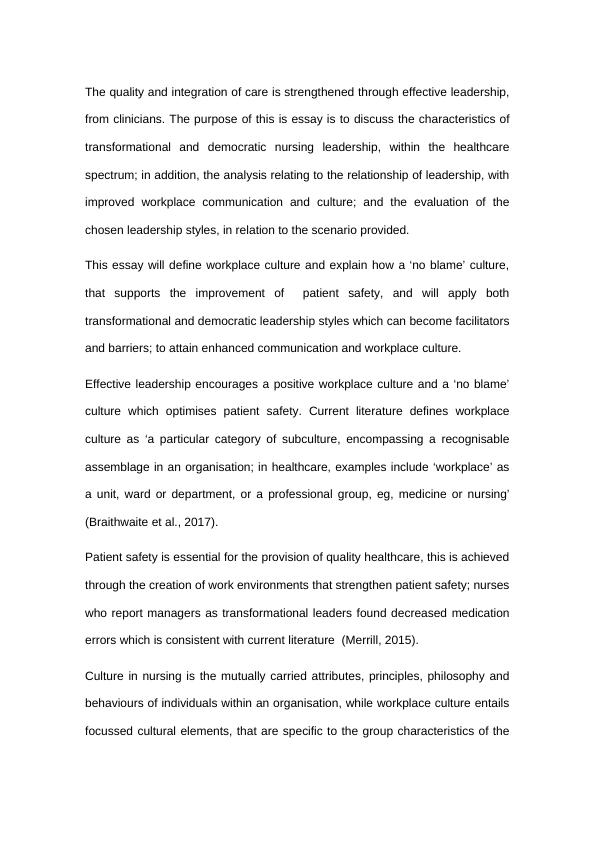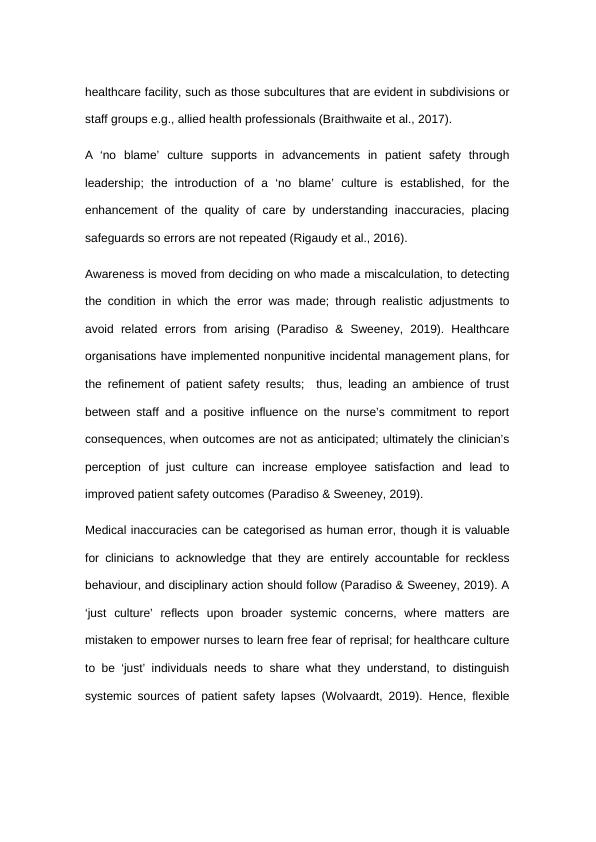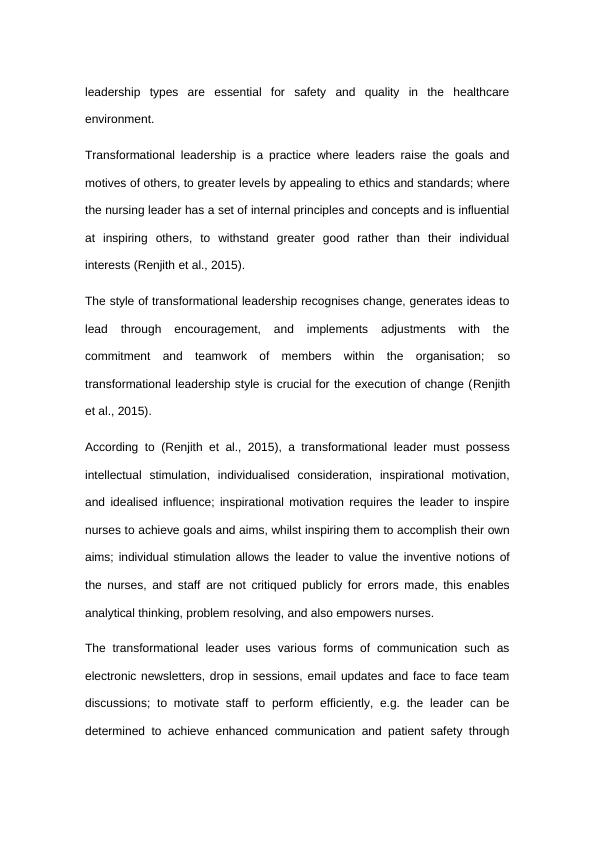Applying Transformational Leadership in Nursing Practice
Added on 2021-09-10
9 Pages2181 Words90 Views
The quality and integration of care is strengthened through effective leadership,
from clinicians. The purpose of this is essay is to discuss the characteristics of
transformational and democratic nursing leadership, within the healthcare
spectrum; in addition, the analysis relating to the relationship of leadership, with
improved workplace communication and culture; and the evaluation of the
chosen leadership styles, in relation to the scenario provided.
This essay will define workplace culture and explain how a ‘no blame’ culture,
that supports the improvement of patient safety, and will apply both
transformational and democratic leadership styles which can become facilitators
and barriers; to attain enhanced communication and workplace culture.
Effective leadership encourages a positive workplace culture and a ‘no blame’
culture which optimises patient safety. Current literature defines workplace
culture as ‘a particular category of subculture, encompassing a recognisable
assemblage in an organisation; in healthcare, examples include ‘workplace’ as
a unit, ward or department, or a professional group, eg, medicine or nursing’
(Braithwaite et al., 2017).
Patient safety is essential for the provision of quality healthcare, this is achieved
through the creation of work environments that strengthen patient safety; nurses
who report managers as transformational leaders found decreased medication
errors which is consistent with current literature (Merrill, 2015).
Culture in nursing is the mutually carried attributes, principles, philosophy and
behaviours of individuals within an organisation, while workplace culture entails
focussed cultural elements, that are specific to the group characteristics of the
from clinicians. The purpose of this is essay is to discuss the characteristics of
transformational and democratic nursing leadership, within the healthcare
spectrum; in addition, the analysis relating to the relationship of leadership, with
improved workplace communication and culture; and the evaluation of the
chosen leadership styles, in relation to the scenario provided.
This essay will define workplace culture and explain how a ‘no blame’ culture,
that supports the improvement of patient safety, and will apply both
transformational and democratic leadership styles which can become facilitators
and barriers; to attain enhanced communication and workplace culture.
Effective leadership encourages a positive workplace culture and a ‘no blame’
culture which optimises patient safety. Current literature defines workplace
culture as ‘a particular category of subculture, encompassing a recognisable
assemblage in an organisation; in healthcare, examples include ‘workplace’ as
a unit, ward or department, or a professional group, eg, medicine or nursing’
(Braithwaite et al., 2017).
Patient safety is essential for the provision of quality healthcare, this is achieved
through the creation of work environments that strengthen patient safety; nurses
who report managers as transformational leaders found decreased medication
errors which is consistent with current literature (Merrill, 2015).
Culture in nursing is the mutually carried attributes, principles, philosophy and
behaviours of individuals within an organisation, while workplace culture entails
focussed cultural elements, that are specific to the group characteristics of the

healthcare facility, such as those subcultures that are evident in subdivisions or
staff groups e.g., allied health professionals (Braithwaite et al., 2017).
A ‘no blame’ culture supports in advancements in patient safety through
leadership; the introduction of a ‘no blame’ culture is established, for the
enhancement of the quality of care by understanding inaccuracies, placing
safeguards so errors are not repeated (Rigaudy et al., 2016).
Awareness is moved from deciding on who made a miscalculation, to detecting
the condition in which the error was made; through realistic adjustments to
avoid related errors from arising (Paradiso & Sweeney, 2019). Healthcare
organisations have implemented nonpunitive incidental management plans, for
the refinement of patient safety results; thus, leading an ambience of trust
between staff and a positive influence on the nurse’s commitment to report
consequences, when outcomes are not as anticipated; ultimately the clinician’s
perception of just culture can increase employee satisfaction and lead to
improved patient safety outcomes (Paradiso & Sweeney, 2019).
Medical inaccuracies can be categorised as human error, though it is valuable
for clinicians to acknowledge that they are entirely accountable for reckless
behaviour, and disciplinary action should follow (Paradiso & Sweeney, 2019). A
‘just culture’ reflects upon broader systemic concerns, where matters are
mistaken to empower nurses to learn free fear of reprisal; for healthcare culture
to be ‘just’ individuals needs to share what they understand, to distinguish
systemic sources of patient safety lapses (Wolvaardt, 2019). Hence, flexible
staff groups e.g., allied health professionals (Braithwaite et al., 2017).
A ‘no blame’ culture supports in advancements in patient safety through
leadership; the introduction of a ‘no blame’ culture is established, for the
enhancement of the quality of care by understanding inaccuracies, placing
safeguards so errors are not repeated (Rigaudy et al., 2016).
Awareness is moved from deciding on who made a miscalculation, to detecting
the condition in which the error was made; through realistic adjustments to
avoid related errors from arising (Paradiso & Sweeney, 2019). Healthcare
organisations have implemented nonpunitive incidental management plans, for
the refinement of patient safety results; thus, leading an ambience of trust
between staff and a positive influence on the nurse’s commitment to report
consequences, when outcomes are not as anticipated; ultimately the clinician’s
perception of just culture can increase employee satisfaction and lead to
improved patient safety outcomes (Paradiso & Sweeney, 2019).
Medical inaccuracies can be categorised as human error, though it is valuable
for clinicians to acknowledge that they are entirely accountable for reckless
behaviour, and disciplinary action should follow (Paradiso & Sweeney, 2019). A
‘just culture’ reflects upon broader systemic concerns, where matters are
mistaken to empower nurses to learn free fear of reprisal; for healthcare culture
to be ‘just’ individuals needs to share what they understand, to distinguish
systemic sources of patient safety lapses (Wolvaardt, 2019). Hence, flexible

leadership types are essential for safety and quality in the healthcare
environment.
Transformational leadership is a practice where leaders raise the goals and
motives of others, to greater levels by appealing to ethics and standards; where
the nursing leader has a set of internal principles and concepts and is influential
at inspiring others, to withstand greater good rather than their individual
interests (Renjith et al., 2015).
The style of transformational leadership recognises change, generates ideas to
lead through encouragement, and implements adjustments with the
commitment and teamwork of members within the organisation; so
transformational leadership style is crucial for the execution of change (Renjith
et al., 2015).
According to (Renjith et al., 2015), a transformational leader must possess
intellectual stimulation, individualised consideration, inspirational motivation,
and idealised influence; inspirational motivation requires the leader to inspire
nurses to achieve goals and aims, whilst inspiring them to accomplish their own
aims; individual stimulation allows the leader to value the inventive notions of
the nurses, and staff are not critiqued publicly for errors made, this enables
analytical thinking, problem resolving, and also empowers nurses.
The transformational leader uses various forms of communication such as
electronic newsletters, drop in sessions, email updates and face to face team
discussions; to motivate staff to perform efficiently, e.g. the leader can be
determined to achieve enhanced communication and patient safety through
environment.
Transformational leadership is a practice where leaders raise the goals and
motives of others, to greater levels by appealing to ethics and standards; where
the nursing leader has a set of internal principles and concepts and is influential
at inspiring others, to withstand greater good rather than their individual
interests (Renjith et al., 2015).
The style of transformational leadership recognises change, generates ideas to
lead through encouragement, and implements adjustments with the
commitment and teamwork of members within the organisation; so
transformational leadership style is crucial for the execution of change (Renjith
et al., 2015).
According to (Renjith et al., 2015), a transformational leader must possess
intellectual stimulation, individualised consideration, inspirational motivation,
and idealised influence; inspirational motivation requires the leader to inspire
nurses to achieve goals and aims, whilst inspiring them to accomplish their own
aims; individual stimulation allows the leader to value the inventive notions of
the nurses, and staff are not critiqued publicly for errors made, this enables
analytical thinking, problem resolving, and also empowers nurses.
The transformational leader uses various forms of communication such as
electronic newsletters, drop in sessions, email updates and face to face team
discussions; to motivate staff to perform efficiently, e.g. the leader can be
determined to achieve enhanced communication and patient safety through

End of preview
Want to access all the pages? Upload your documents or become a member.
Related Documents
Clinical Leadership and Profession Relationshiplg...
|8
|2113
|1
Leadership Styles and Workplace Culture in Healthcarelg...
|9
|2318
|141
Leadership Styles and Workplace Culture in Healthcarelg...
|9
|2682
|371
Nursing Leadership in Patient Safety Healthcarelg...
|7
|1904
|43
Nursing Leadership: Improving Patient Safety and Outcomeslg...
|8
|2185
|195
Leadership in Nursing and its Impact on Patient Safetylg...
|10
|2429
|197
